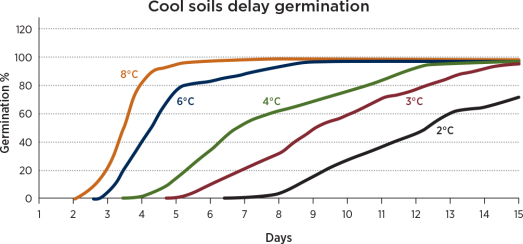Earlier seeding generally increases yield
Early spring seeding typically benefits canola yield and quality. An early planting date enables the crop to take advantage of good spring moisture, avoid some heat stress at flowering, and reduce the risk of fall frost damage.
Key practice: Crops seeded early (in late April or early May, depending on the region) will out-yield canola seeded in late May to early June most years. Not all years, but most years.
Key research: Angadi, S.V., Agriculture and Agri-Food Canada (AAFC), et al. “Early Seeding Improves the Sustainability of Canola and Mustard Production on the Canadian Semiarid Prairie.” Canadian Journal of Plant Science (2004).
Brandt, Stewart, AAFC, et al. “Evaluating the Agronomic and Economic Value of High Quality Canola Seed.” Canola Agronomic Research Program (CARP) (11-01-08).
Kirkland, Ken J., AAFC and Johnson, Eric N., AAFC. “Alternative Seeding Dates (Fall and April) Affect Brassica napus Canola Yield and Quality.” Canadian Journal of Plant Science (2000).
Capo-chichi, Ludovic J.A., Alberta Innovates, et al. “Assessment of Seed Germination and Seedling Performance of Spring Canola at Low Temperatures.” CARP (2011-7).
Generally, soil temperatures below 8 to 10°C result in progressively poorer germination and emergence. However, early seeding in late April or early May often provides yield benefits in spite of this — as long as an adequate plant population survives. Starting to seed when soil temperatures in the zone reach 5°C is a reasonable compromise, or even earlier if the forecast is for temperatures to rise the week following seeding.
It is important, therefore, to consider local weather history and frost risk when choosing a seeding date. The frost-free period varies considerably from location to location in Canada and the actual dates of final spring frost and first fall frost are different each year.
Through a four-year study conducted at the AAFC research farm near Scott, SK, Ken Kirkland and Eric Johnson found that canola seeded late fall or early spring yielded up to 38 percent more compared to traditional mid-May seeding. Fall seeding canola is a high-risk practice and is not recommended, but this study does support early spring seeding.
S.V. Angadi of AAFC et al, referenced those findings in the 2004 paper “Early Seeding Improves the Sustainability of Canola and Mustard Production on the Canadian Semiarid Prairie.” Angadi also summarized a four-yield field study at the Semiarid Prairie Agricultural Research Centre in Swift Current to examine the effect of fall and spring seeding on the growth and water-use characteristics of three canola species.
In the Swift Current study, seeding dates were late fall (November 2 to 23 just before soil freezing), early spring (April 24 to 26) and late spring (May 23 to 25). The lowest plant populations occurred with fall seeding, but early seeding generally resulted in earlier flowering, avoiding mid- to late-summer heat stress.
The effect of seeding date on yield was very dependent on available water throughout the growing season. In the year with the most typical moisture conditions, early spring seeded crops produced the highest yield, followed by fall seeded and then late spring seeded. Planned comparisons also showed higher water-use efficiency with early spring seeding compared to late spring seeding.

Angadi concluded with a recommendation to seed canola as early in spring as practical, because this seeding date is most likely to produce the highest seed yields.
Stewart Brandt et al of AAFC also conducted a two-year seed timing study for Saskatchewan Canola Development Commission (SCDC), “Evaluating the Agronomic and Economic Value of High Quality Canola Seed.” The study found that plots seeded prior to May 20 resulted in higher seedling establishment, canola biomass and seed yield compared to those seeded on June 3. “Seed growers should try to seed their canola in early to mid-May to produce high vigour seed,” reported Brandt.
Some gains may also be made through breeding canola for low temperature tolerance, but this can be very challenging. J.A. Ludovic Capo-chichi of Alberta Innovates completed the study, “Assessment of Seed Germination and Seeding Performance of Spring Canola at Low Temperatures,” in March 2014. He concluded: “To improve efficiency and increase the tolerance of low temperature, canola breeders must exploit new screen techniques to complete previously used methods. This project has generated a huge amount of information and tools that will be useful in breeding programs and other projects aimed at understanding the physiology and genomics of low temperature tolerance in spring canola.”




